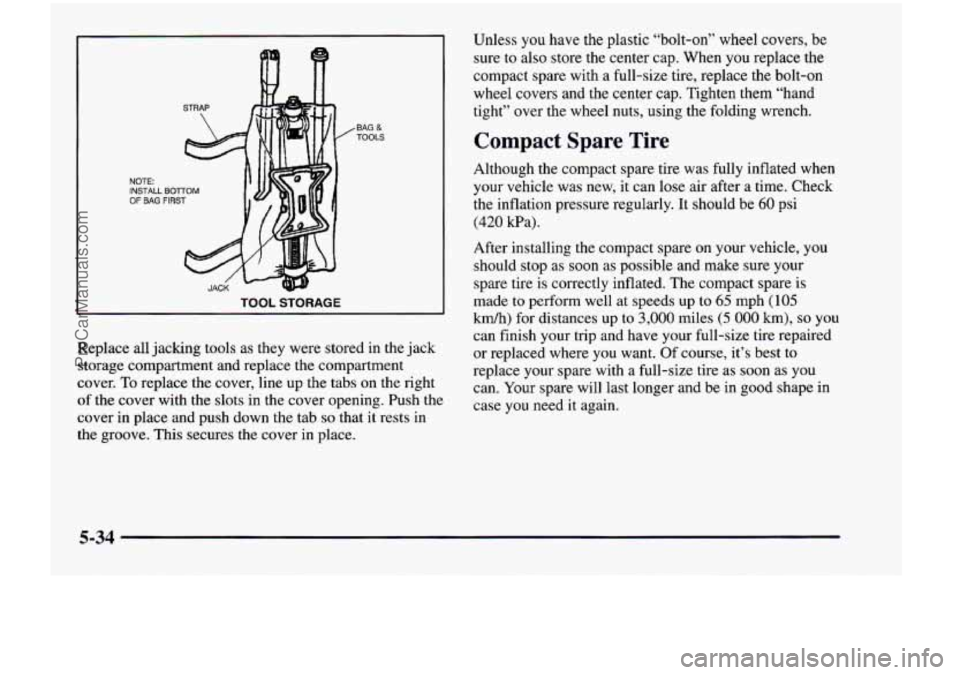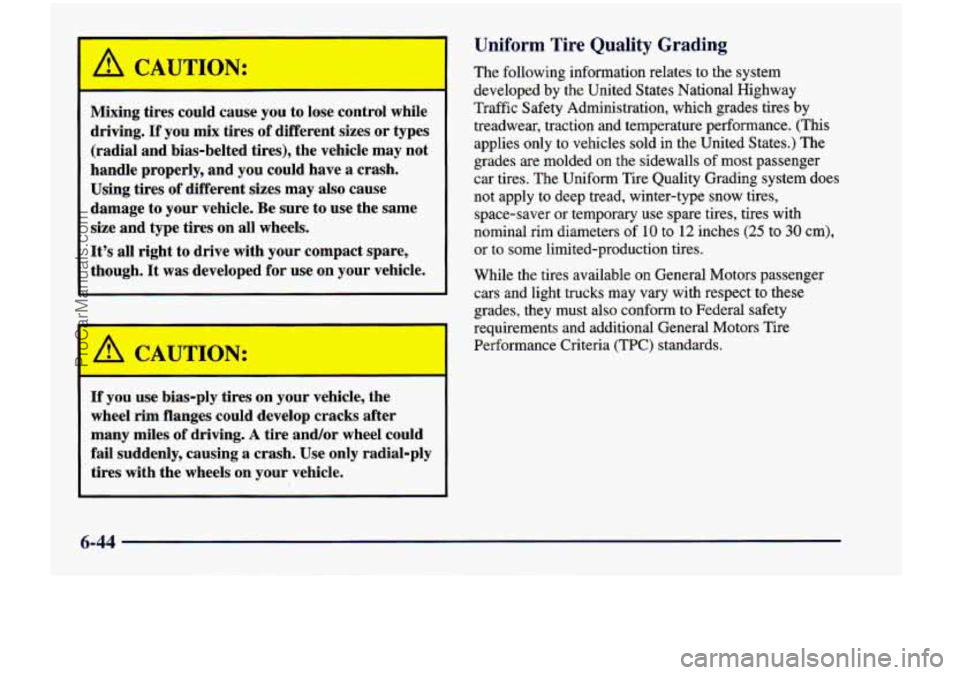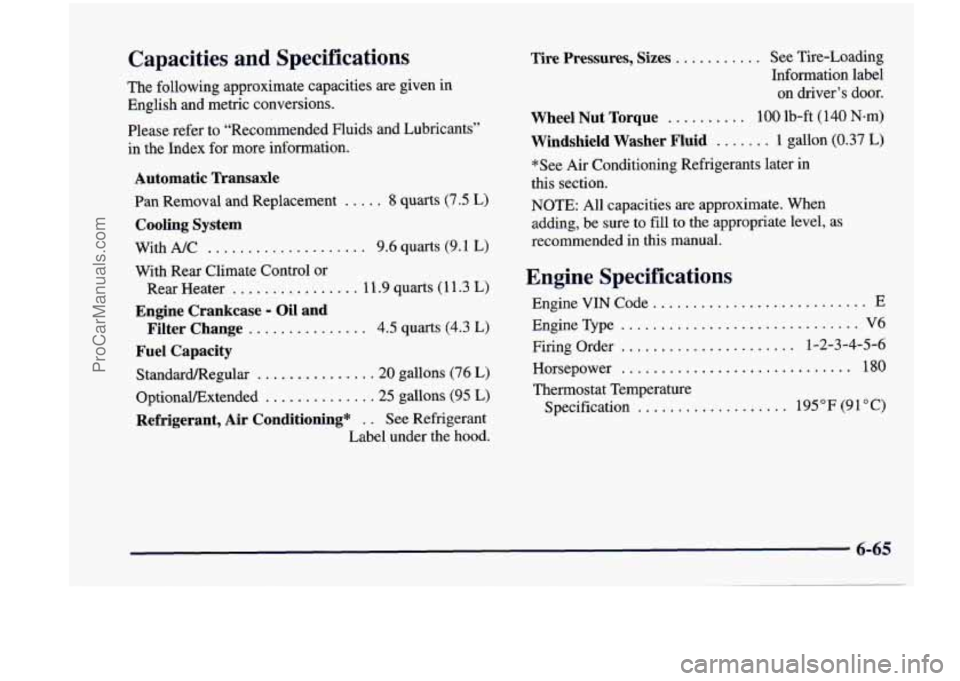1998 CHEVROLET VENTURE wheel size
[x] Cancel search: wheel sizePage 331 of 474

NOTE:
INSTALL
OF BAG , BOlTOM
.BAG & TOOLS
I TOOL STORAGE
Replace all jacking tools as they were stored in the jack
storage compartment and replace the compartment
cover. To replace the cover, line up the tabs on the right
of the cover with the slots
in the cover opening. Push the
cover in place and push down the tab
so that it rests in
the groove. This secures the cover in place. Unless you have the plastic “bolt-on” wheel covers, be
sure
to also store the center cap. When you replace the
compact spare with
a full-size tire, replace the bolt-on
wheel covers and the center cap. Tighten them “hand
tight” over the wheel nuts, using the folding wrench.
Compact Spare Tire
Although the compact spare tire was fully inflated when
your vehicle was new, it can lose air after a time. Check
the inflation pressure regularly. It should be
60 psi
(420 Pa).
After installing the compact spare on your vehicle, you
should stop as soon as possible and make sure your
spare tire
is correctly inflated. The compact spare is
made
to perform well at speeds up to 65 mph (105
km/h) for distances up to 3,000 miles (5 000 km), so you
can finish your trip and have your full-size tire repaired
or replaced where
you want. Of course, it’s best to
replace your spare with a full-size tire as soon as you
can. Your spare will last longer and be in good shape in
case you need it again.
5-34
ProCarManuals.com
Page 379 of 474

Mixing tires could cause you to lose control while
driving.
If you mix tires of different sizes or types
(radial and bias-belted tires), the vehicle may not
handle properly, and you could have a crash.
Using tires
of different sizes may also cause
damage to your vehicle. Be sure to use the same
size and type tires on all wheels.
It’s all right to drive with your compact spare,
though. It was developed
for use on your vehicle.
If you use bias-ply tires on your vehicle, the
wheel rim flanges could develop cracks after
many miles
of driving. A tire and/or wheel could
fail suddenly, causing
a crash. Use only radial-ply
tires with the wheels
on your vehicle.
Uniform Tire Quality Grading
The following information relates to the system
developed by the United States National Highway
Traffic Safety Administration, which grades tires
by
treadwear, traction and temperature performance. (This
applies only to vehicles sold in the United States.) The
grades are molded on
the sidewalls of most passenger
car tires. The Uniform Tire Quality Grading system does
not apply to deep tread, winter-type snow tires,
space-saver
or temporary use spare tires, tires with
nominal rim diameters
of 10 to 12 inches (25 to 30 cm),
or to some limited-production tires.
While the tires available
on General Motors passenger
cars and light trucks may vary with respect to these
grades, they must also conform to Federal safety
requirements and additional General Motors Tire
Performance Criteria (TPC) standards.
6-44
ProCarManuals.com
Page 382 of 474

~
~ 1 Tire Chains
NOTICE:
The wrong wheel can also cause problems with
bearing life, brake cooling, speedometer or
odometer calibration, headlamp aim, bumper
height, vehicle ground clearance and tire or tire
chain clearance to the body and chassis.
See “Changing a Flat Tire” in the Index for
more information.
Putting
a used wheel on your vehicle is
dangerous. You can’t know how it’s been used or
how
far it’s been driven. It could fail suddenly
and cause an accident.
If you have to replace a
wheel, use a new GM original equipment wheel.
NOTICE:
Use tire chains only where legal and only when
you must. Use only
SAE Class “S” type chains
that are the proper size for your tires. Install
them on the front tires and tighten them
as
tightly as possible with the ends securely
fastened. Drive slowly and follow the chain
manufacturer’s instructions.
If you can hear the
chains contacting your vehicle, stop and retighten
them.
If the contact continues, slow down until it
stops. Driving
too fast or spinning the wheels
with chains on will damage your vehicle.
6-47
ProCarManuals.com
Page 390 of 474

Appearance Care Materials Chart
PART NUMBER I SIZE
994954 I 23 in. x 25 in.
1050172 I 16 02. (0.473 L)
~~~~ ~~
1050173 16
oz. (0.473 L) 1052870 23
oz. (0.680 L) 1050427 32
oz. (0.946 L) 1050214
16
oz. (0.473 L) 1050174 16
02. (0.473 L)
DESCRIPTION
Exterior
polishing cloth
Polishing Cloth - Wax
Treated
USAGE
Tar and Road Oil Remover
Use on chrome, stainless steel, nickel, copper and brass
Chrome Cleaner and Polish Removes
tar, road oil and asphalt
Removes soil and black marks from whitewalls
White Sidewall Tire Cleaner
Vinyl Cleaner
Glass Cleaner Cleans vinyl tops,
upholstery and convertible tops
Removes dirt, grime, smoke and fingerprints
Wash Wax Concentrate Cleans and lightly waxes
1052918”” I 8 oz. (0.237 L) Armor All Protectant Protects
leather, wood, acrylics, Plexiglas TM , plastic,
rubber and vinyl
1052925 I 16 oz. (0.473 L) I
Multi-Purpose Interior
Cleans carpets, seats, interior trim, door panels
Cleaner and
floor mats I
1052929 I 16 oz. (0.473 L) I Wheel Cleaner I Spray on and rinse with water
1052930
Spray on tire shine
Silicone Tire Shine 12 02. (0.354 L) 12345725
Shines
vehicle without scratching
Synthetic Chamois 2.5 sq. ft. 12345721
Cleans and
shines a variety of surface types
Armor
All TM Cleaner 16 oz. (0.473 L) 12345002
Attracts, absorbs and removes soils Capture Dry Spot Remover 8 oz. (0.237 L)
12377964
See your General Motors Parts Department for these products. ** Not recommended for use on instrument panel vinyl.
Removes contaminants, blemishes
and swirl marks
Surface Cleaner
16 oz. (0.473 L) 12377984
Removes light scratches and oxidation and protects finish
Cleaner
Wax 16 02. (0.473 L) 12377966
Removes dust, fingerprints and surface contaminants
Finish
Enhancer 16 02. (0.473 L)
See “Fluids and Lubricants’’ in the Index.
6-55
ProCarManuals.com
Page 400 of 474

Capacities and Specifications
The following approximate capacities are given in
English and metric conversions.
Please refer to “Recommended Fluids and Lubricants”
in the Index for more information.
Automatic Transaxle
Pan Removal and Replacement ..... 8 quarts (7.5 L)
Cooling System
With A/C .................... 9.6 quarts (9.1 L)
With Rear Climate Control or
Engine Crankcase - Oil and
Fuel Capacity
Rear Heater ................ 11.9 quarts (11.3 L)
Filter Change ............... 4.5 quarts (4.3 L)
StandardRegular .............. .20 gallons (76 L)
OptionaVExtended ............. .25 gallons (95 L)
Refrigerant, Air Conditioning* . . See Refrigerant
Label under the hood.
Tire Pressures, Sizes ........... See Tire-Loading
Information label
on driver’s door.
Wheel Nut Torque .......... 100 lb-ft (140 N-m)
Windshield Washer Fluid ....... 1 gallon (0.37 L)
*See Air Conditioning Refrigerants later in
this section.
NOTE: All capacities are approximate. When
adding,
be sure to fill to the appropriate level, as
recommended in
this manual.
Engine Specifications
Engine VIN Code ........................... E
Firing Order ...................... 1-2-3-4-5-6
EngineType
.............................. V6
Horsepower ............................. 180
Thermostat
Temperature
Specification
................... 195 “F (91 “C)
6-65
ProCarManuals.com